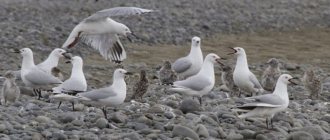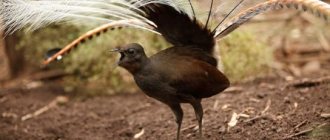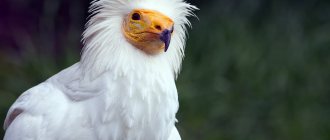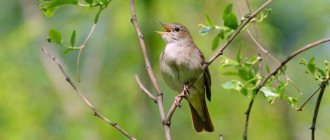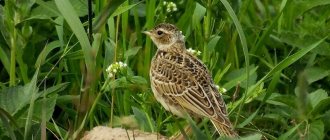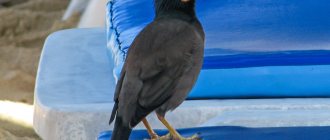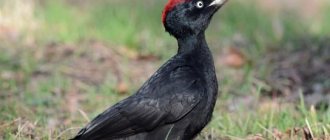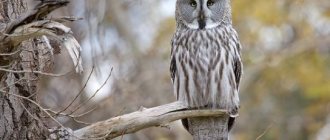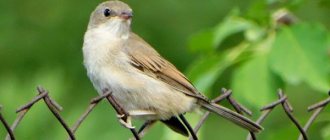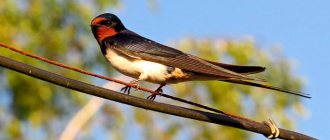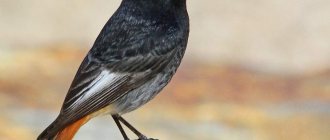WHERE DOES IT LIVE?
The black-headed warbler is found throughout most of Europe, Asia Minor and North Africa. In most nesting areas, this is a migratory bird; in the fall it flies to warmer climes. The black-headed warbler returns to its nesting sites quite late (in April - early May). But over the summer the birds manage to give birth to two offspring. The birds fly to their wintering grounds in September-October. They spend the winter in Mediterranean countries. The British population of warblers live within their territory all year round. In winter, birds stay in city gardens and parks. The black-headed warbler is a common inhabitant of forests, but recently it can also be found in city parks and gardens. Warblers make their nests at a height of 1-2 meters above the ground on deciduous or coniferous trees; Often the nest can be seen on the branches of low bushes. The black-headed warbler has a graceful body structure. Females are slightly smaller than males. Juvenile black-headed warblers are very similar in color to the female.
Nutrition
Their food is insects, their larvae, berries, and small seeds. At first glance, the diet is modest, but hidden behind it is real environmental activity. None of the warblers cause significant harm to humans; they are not capable of greatly destroying berry fields or pecking at fields. And the benefits from them are significant, although at first glance they seem invisible.
Insects are the main pests of gardens and forests. Weevils, leaf beetles, bugs, sawflies, caterpillars, mosquitoes, flies, dragonflies - everything that small warblers feed on is considered harmful to the forest and garden. Our warblers diligently “clean” trees and bushes of them all summer. And closer to autumn, birds are more inclined to eat plant foods.
They peck the berries of rowan, raspberry, blueberry, elderberry, bird cherry, honeysuckle, blueberry and blackberry. These birds are also distributors of plants, since the seeds are not digested in their stomachs. The dispersal of seeds by birds is called ornitochory. It turns out that these little heroes are not only orderlies, but also serious helpers of nature. So easily and naturally, with a cheerful song, they do great and necessary work over the summer.
REPRODUCTION
Birds from wintering areas return to nesting sites in April - early May. Immediately after arrival, the males occupy the territory and begin to sing. By singing, they warn rivals that the area is occupied and call for a female. The male's singing consists of quiet talking, occasionally interrupted by a loud whistle. Birds in pairs begin building a nest 10-18 days after arrival. The warbler's nest is made at a height of about 1-2 meters above the ground, on small fir trees, in bushes of deciduous undergrowth. Birds build it from horsehair and dry stems. The female incubates the eggs for 10-12 days. The first days after the chicks hatch, she does not leave the nest. After 2-3 days, the female flies out of the nest and, together with the male, begins to feed the cubs. The chicks that fly out of the nest are fed by their parents for 10 days, and then begin the second clutch.
Catching blackheads and keeping them at home
Black-headed birds are caught immediately after their arrival from wintering grounds. Basically, catching is carried out with the help of wind-up birds. However, you can also use hanging nets.
After you have managed to catch the black-headed bird, you need to tie its wings. Then it should be placed in a small cage, which should be covered on all sides with light-colored material.
Blackheads should be given special attention , as they are quite fastidious creatures.
The first weeks of life in a cage are very important. During this time, black-headed birds must get used to the cramped space and to the new way of feeding.
There should always be a small container of clean water in the cage. The food can be sprinkled directly on the floor for the first time.
Feeding the Warbler at home
The metabolism of black-headed warblers is at a high level. Therefore, even four hours without food can kill them .
At first, in addition to nightingale mixtures, blackheads must also be given live food (cockroaches, mealworms). You can transfer the bird to another room when it learns to eat normally in captivity.
You cannot overfeed warblers that are kept in a cage. This can lead to obesity. The bird will lose the ability not only to fly fully, but also to take off even on a perch.
Arranging a cage for blackheads
The cage for these birds should be small, but in no case cramped. In cages that are too spacious, blackheads remain wild for a long time, and in cramped ones they lose their plumage.
The length of the cage should be about half a meter, and the width and height of about thirty centimeters. It is best to make a bird house from wood. This material is considered safer for keeping birds. The wooden rods of the cage can be varnished.
It is important to cover the top of the cage with material, as the bird may fly up suddenly and injure itself on the cage.
Lighting for blackheads kept in captivity
Blackheads are very sensitive birds, so special attention should be paid to lighting. This is especially true in the winter. With insufficient lighting, birds may experience hormonal imbalances.
The duration of daylight in summer should be about 16 hours, and in winter about 11 hours.
If the maintenance rules are not followed, blackheads most often die during the first molt. If favorable conditions are created for the birds, they can live in captivity for about ten years.
OBSERVATIONS OF THE WARRIOR
The black-headed warbler appears at the nesting sites quite late - in April or early May. The males immediately occupy the nesting sites and sing their “wedding” song. They sing while sitting on a branch of a tree or bush. The song of the black-headed warbler consists of a quiet “talk”, which sometimes alternates with a rather loud whistle. The singing of the black-headed warbler is distinguished by an impressive variety of strength and sonority. It vaguely resembles the murmur of a spring stream. These birds are true forest dwellers (they prefer coniferous forests), but they often settle in groves, parks and gardens. Here black-headed warblers live all summer until autumn and hatch their chicks twice.
INTERESTING FACTS, INFORMATION…
- Males are distinguished by the fact that they are able to imitate the voices of other birds; for example, their song contains motifs from the songs of songbirds, blackbirds, nightingales and robins. One of this bird's relatives is the mockingbird.
- Previously, warblers were often kept in houses. The quiet iridescent chirping of these birds had a calming effect on their owners.
- Warblers fly to their wintering grounds at night. It is believed that birds in flight are guided by the position of the North Star. It was also noted that adults fly to nesting sites first.
- Externally, many species of warblers are very similar, but they differ in their voice. In some warblers, the song sounds like flute music, while in others it is fragmentary.
CHARACTERISTIC FEATURES OF THE BLACK-HEADED WARBLER. DESCRIPTION
Male: the forehead and crown are black, the back of the head, neck and rump of the bird are gray, and the rest of the plumage is olive-brown.
Laying: the female lays 4-5 eggs. The nest is cup-shaped, openwork, translucent. The eggs are dirty white, with vague brown spots.
Beak: short and sharp, dark horny. Adapted for picking berries on trees and catching insects.
Female: she has a reddish-brown cap on her head, the underside of the body is browner.
— The whole year — Wintering — Nesting
WHERE DOES IT LIVE?
The Black-headed Warbler nests throughout Europe (it is a forest dweller) and on adjacent islands. In addition, warblers are found in Asia Minor and North Africa. These are migratory birds that winter in Greece, Spain and North Africa.
PROTECTION AND PRESERVATION
In Central Europe, the Black-headed Warbler is quite common these days.
Bird calls - Black-headed Warbler (Sylvia atricapilla). Video (00:00:59)
The Black-headed Warbler lives in forests with undergrowth, on forest edges, clearings, in thickets along river banks, and penetrates mountains, as well as gardens and city parks. Its habitat extends throughout Europe, except the Far North, and extends into Western Siberia. It also nests in northwestern Africa. This species is characterized by the presence of a black “cap” on the head in males and a red one in females. The general color of the birds is brownish-gray, with the abdomen being somewhat lighter. one of the best singers among passerine birds. In terms of sonority, strength and purity of song, the blackbird boldly competes with such unsurpassed singers as the nightingale, blackbird and songbird.
Features and habitat
Ornithologists have estimated that there are more than a hundred birds of the warbler family on our planet. In the European part, there are only 12 species of warblers. Prominent representatives of this genus are the gray warbler, the hawk's warbler, the garden warbler and the black-headed warbler. These are the ones that will be discussed further.
The gray warbler is a bird slightly smaller than a sparrow. The plumage on all parts of the body is different. For example, the back is painted in shades of gray with hints of brown, the head is covered with ash-colored feathers, the shoulder part is red, the neck is white, and the rest of the abdomen is covered with pale pink plumage.
Gray warblers live in open forests and bushes. You can find them in ravines, ravines, overgrown with reeds and wormwood; you can often see them in fields and gardens. The garden warbler, also known as the garden warbler, is a slightly larger bird than its close relative the gray warbler.
The length without the tail in large individuals reaches 15 cm, and body weight ranges from 15 to 25 grams.
In the photo there is a garden warbler bird
In terms of color, the garden warbler is slightly inferior in color palette; its main color is brown-gray, sometimes with a subtle olive tint; the abdomen, breast and undertail are milky in color. The feathers of the wings and the tail are framed by a narrow edging of dirty yellow color.
Around the eyes of the bird, the feathers are painted white, which from a distance resembles glasses. The curved beak and rather slender legs are painted the color of wet asphalt. All of the colors listed are unsaturated, one might even say dull. Females and males are identical in plumage color.
The garden warbler settles on the banks of rivers overgrown with bushes. She feels at home on forest edges, of which there are a lot in the southern regions of Western Siberia, as well as in the central regions of this region rich in forests. The warbler is a migratory bird and, as usual, spends its winter holidays on the African continent.
The next bird species that will be discussed is the black-headed warbler. In the description of this species of warbler, it should be noted that the bird is not much different from the species described above, but there is a slight difference in color.
Thus, the head of the blackhead, as is already clear from the name, is painted in a rich black color, and this coloring is a distinctive sign of males, and the distinctive feature of the female warbler is the red coloring of the chest and head of the bird.
Black-headed warbler bird
The largest representative of this family is the hawk's warbler . The size of the pichuga is 18, and sometimes 20 cm, and the weight is as much as 35 grams. The feathers located on the back are colored in soft tones of olive color, the plumage of the head is slightly darker than on the back.
The feathers above the tail are variegated black and white. The brow ridges of the hawk warbler are edged with white plumage. The cornea of the eyes is painted a dirty yellow color, and the paws are covered with light yellow skin.
In the photo of the warbler, you can clearly see all the nuances that are present in the color of the birds. The Hawk Warbler is a migratory bird. She spends the winter in the eastern regions of Africa.
In the photo the bird is a hawk's warbler.
